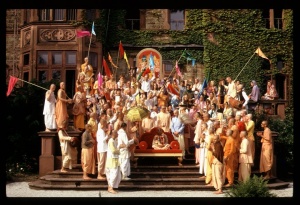SB 1.3.30: Difference between revisions
No edit summary |
(Vanibot #0054 edit - transform synonyms into clickable links, which search similar occurrences) |
||
| Line 24: | Line 24: | ||
<div class="synonyms"> | <div class="synonyms"> | ||
''etat'' | ''[//vanipedia.org/wiki/Special:VaniSearch?s=etat&tab=syno_o&ds=1 etat]'' — all these; ''[//vanipedia.org/wiki/Special:VaniSearch?s=rūpam&tab=syno_o&ds=1 rūpam]'' — forms; ''[//vanipedia.org/wiki/Special:VaniSearch?s=bhagavataḥ&tab=syno_o&ds=1 bhagavataḥ]'' — of the Lord; ''[//vanipedia.org/wiki/Special:VaniSearch?s=hi&tab=syno_o&ds=1 hi]'' — certainly; ''[//vanipedia.org/wiki/Special:VaniSearch?s=arūpasya&tab=syno_o&ds=1 arūpasya]'' — of one who has no material form; ''[//vanipedia.org/wiki/Special:VaniSearch?s=cit&tab=syno_o&ds=1 cit]-[//vanipedia.org/wiki/Special:VaniSearch?s=ātmanaḥ&tab=syno_o&ds=1 ātmanaḥ]'' — of the Transcendence; ''[//vanipedia.org/wiki/Special:VaniSearch?s=māyā&tab=syno_o&ds=1 māyā]'' — material energy; ''[//vanipedia.org/wiki/Special:VaniSearch?s=guṇaiḥ&tab=syno_o&ds=1 guṇaiḥ]'' — by the qualities; ''[//vanipedia.org/wiki/Special:VaniSearch?s=viracitam&tab=syno_o&ds=1 viracitam]'' — manufactured; ''[//vanipedia.org/wiki/Special:VaniSearch?s=mahat&tab=syno_o&ds=1 mahat]-[//vanipedia.org/wiki/Special:VaniSearch?s=ādibhiḥ&tab=syno_o&ds=1 ādibhiḥ]'' — with the ingredients of matter; ''[//vanipedia.org/wiki/Special:VaniSearch?s=ātmani&tab=syno_o&ds=1 ātmani]'' — in the self. | ||
</div> | </div> | ||
Latest revision as of 18:08, 17 February 2024

A.C. Bhaktivedanta Swami Prabhupada
TEXT 30
- etad rūpaṁ bhagavato
- hy arūpasya cid-ātmanaḥ
- māyā-guṇair viracitaṁ
- mahadādibhir ātmani
SYNONYMS
etat — all these; rūpam — forms; bhagavataḥ — of the Lord; hi — certainly; arūpasya — of one who has no material form; cit-ātmanaḥ — of the Transcendence; māyā — material energy; guṇaiḥ — by the qualities; viracitam — manufactured; mahat-ādibhiḥ — with the ingredients of matter; ātmani — in the self.
TRANSLATION
The conception of the virāṭ universal form of the Lord, as appearing in the material world, is imaginary. It is to enable the less intelligent [and neophytes] to adjust to the idea of the Lord's having form. But factually the Lord has no material form.
PURPORT
The conception of the Lord known as the viśva-rūpa or the virāṭ-rūpa is particularly not mentioned along with the various incarnations of the Lord because all the incarnations of the Lord mentioned above are transcendental and there is not a tinge of materialism in their bodies. There is no difference between the body and self as there is in the conditioned soul. The virāṭ-rūpa is conceived for those who are just neophyte worshipers. For them the material virāṭ-rūpa is presented, and it will be explained in the Second Canto. In the virāṭ-rūpa the material manifestations of different planets have been conceived as His legs, hands, etc. Actually all such descriptions are for the neophytes. The neophytes cannot conceive of anything beyond matter. The material conception of the Lord is not counted in the list of His factual forms. As Paramātmā, or Supersoul, the Lord is within each and every material form, even within the atoms, but the outward material form is but an imagination, both for the Lord and for the living being. The present forms of the conditioned souls are also not factual. The conclusion is that the material conception of the body of the Lord as virāṭ is imaginary. Both the Lord and the living beings are living spirits and have original spiritual bodies.